May 2031 lunar eclipse
Penumbral From Wikipedia, the free encyclopedia
A penumbral lunar eclipse will occur at the Moon’s ascending node of orbit on Wednesday, May 7, 2031,[1] with an umbral magnitude of −0.0892. A lunar eclipse occurs when the Moon moves into the Earth's shadow, causing the Moon to be darkened. A penumbral lunar eclipse occurs when part or all of the Moon's near side passes into the Earth's penumbra. Unlike a solar eclipse, which can only be viewed from a relatively small area of the world, a lunar eclipse may be viewed from anywhere on the night side of Earth. Occurring about 2 days before perigee (on May 9, 2031, at 3:35 UTC), the Moon's apparent diameter will be larger.[2]
| Penumbral eclipse | |||||||||
 The Moon's hourly motion shown right to left | |||||||||
| Date | May 7, 2031 | ||||||||
|---|---|---|---|---|---|---|---|---|---|
| Gamma | −1.0694 | ||||||||
| Magnitude | −0.0892 | ||||||||
| Saros cycle | 112 (66 of 72) | ||||||||
| Penumbral | 237 minutes, 21 seconds | ||||||||
| |||||||||
Visibility
The eclipse will be completely visible over eastern North America, South America, Antarctica, and west Africa, seen rising over western North America and the eastern Pacific Ocean and setting over Africa, Europe, and the Middle East.[3]
  |
Eclipse details
Shown below is a table displaying details about this particular solar eclipse. It describes various parameters pertaining to this eclipse.[4]
| Parameter | Value |
|---|---|
| Penumbral Magnitude | 0.88267 |
| Umbral Magnitude | −0.08921 |
| Gamma | −1.06949 |
| Sun Right Ascension | 02h55m49.7s |
| Sun Declination | +16°44'40.2" |
| Sun Semi-Diameter | 15'51.2" |
| Sun Equatorial Horizontal Parallax | 08.7" |
| Moon Right Ascension | 14h54m58.0s |
| Moon Declination | -17°47'29.4" |
| Moon Semi-Diameter | 16'18.7" |
| Moon Equatorial Horizontal Parallax | 0°59'52.0" |
| ΔT | 74.5 s |
Eclipse season
This eclipse is part of an eclipse season, a period, roughly every six months, when eclipses occur. Only two (or occasionally three) eclipse seasons occur each year, and each season lasts about 35 days and repeats just short of six months (173 days) later; thus two full eclipse seasons always occur each year. Either two or three eclipses happen each eclipse season. In the sequence below, each eclipse is separated by a fortnight. The first and last eclipse in this sequence is separated by one synodic month.
| May 7 Ascending node (full moon) | May 21 Descending node (new moon) | June 5 Ascending node (full moon) |
|---|---|---|
 |  |  |
| Penumbral lunar eclipse Lunar Saros 112 | Annular solar eclipse Solar Saros 138 | Penumbral lunar eclipse Lunar Saros 150 |
Related eclipses
Summarize
Perspective
Eclipses in 2031
- A penumbral lunar eclipse on May 7.
- An annular solar eclipse on May 21.
- A penumbral lunar eclipse on June 5.
- A penumbral lunar eclipse on October 30.
- A hybrid solar eclipse on November 14.
Metonic
- Preceded by: Lunar eclipse of July 18, 2027
- Followed by: Lunar eclipse of February 22, 2035
Tzolkinex
- Preceded by: Lunar eclipse of March 25, 2024
- Followed by: Lunar eclipse of June 17, 2038
Half-Saros
- Preceded by: Solar eclipse of April 30, 2022
- Followed by: Solar eclipse of May 11, 2040
Tritos
- Preceded by: Lunar eclipse of June 5, 2020
- Followed by: Lunar eclipse of April 5, 2042
Lunar Saros 112
- Preceded by: Lunar eclipse of April 25, 2013
- Followed by: Lunar eclipse of May 17, 2049
Inex
- Preceded by: Lunar eclipse of May 26, 2002
- Followed by: Lunar eclipse of April 15, 2060
Triad
- Preceded by: Lunar eclipse of July 6, 1944
- Followed by: Lunar eclipse of March 7, 2118
Lunar eclipses of 2031–2034
This eclipse is a member of a semester series. An eclipse in a semester series of lunar eclipses repeats approximately every 177 days and 4 hours (a semester) at alternating nodes of the Moon's orbit.[5]
The penumbral lunar eclipse on June 5, 2031 occurs in the previous lunar year eclipse set.
| Lunar eclipse series sets from 2031 to 2034 | ||||||||
|---|---|---|---|---|---|---|---|---|
| Ascending node | Descending node | |||||||
| Saros | Date Viewing |
Type Chart |
Gamma | Saros | Date Viewing |
Type Chart |
Gamma | |
| 112 | 2031 May 07 |
Penumbral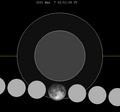 |
−1.0694 | 117 | 2031 Oct 30 |
Penumbral |
1.1774 | |
| 122 | 2032 Apr 25 |
Total |
−0.3558 | 127 | 2032 Oct 18 |
Total |
0.4169 | |
| 132 | 2033 Apr 14 |
Total |
0.3954 | 137 | 2033 Oct 08 |
Total |
−0.2889 | |
| 142 | 2034 Apr 03 |
Penumbral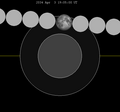 |
1.1144 | 147 | 2034 Sep 28 |
Partial |
−1.0110 | |
Saros 112
This eclipse is a part of Saros series 112, repeating every 18 years, 11 days, and containing 72 events. The series started with a penumbral lunar eclipse on May 20, 859 AD. It contains partial eclipses from August 3, 985 AD through March 8, 1346; total eclipses from March 18, 1364 through August 27, 1616; and a second set of partial eclipses from September 7, 1634 through April 25, 2013. The series ends at member 72 as a penumbral eclipse on July 12, 2139.
The longest duration of totality was produced by member 36 at 99 minutes, 51 seconds on June 2, 1490. All eclipses in this series occur at the Moon’s ascending node of orbit.[6]
| Greatest | First | |||
|---|---|---|---|---|
| The greatest eclipse of the series occurred on 1490 Jun 02, lasting 99 minutes, 51 seconds.[7] | Penumbral | Partial | Total | Central |
| 859 May 20 |
985 Aug 03 |
1364 Mar 18 |
1436 Apr 30 | |
| Last | ||||
| Central | Total | Partial | Penumbral | |
| 1562 Jul 16 |
1616 Aug 27 |
2013 Apr 25 |
2139 Jul 12 | |
Eclipses are tabulated in three columns; every third eclipse in the same column is one exeligmos apart, so they all cast shadows over approximately the same parts of the Earth.
| Series members 54–72 occur between 1801 and 2139: | |||||
|---|---|---|---|---|---|
| 54 | 55 | 56 | |||
| 1814 Dec 26 | 1833 Jan 06 | 1851 Jan 17 | |||
| 57 | 58 | 59 | |||
| 1869 Jan 28 | 1887 Feb 08 | 1905 Feb 19 | |||
 |
 | ||||
| 60 | 61 | 62 | |||
| 1923 Mar 03 | 1941 Mar 13 | 1959 Mar 24 | |||
 |
 |
 |
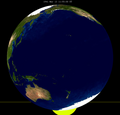 |
 |
 |
| 63 | 64 | 65 | |||
| 1977 Apr 04 | 1995 Apr 15 | 2013 Apr 25 | |||
 |
 |
 |
 |
 |
 |
| 66 | 67 | 68 | |||
| 2031 May 07 | 2049 May 17 | 2067 May 28 | |||
 |
 |
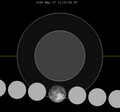 |
 |
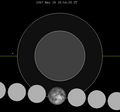 |
 |
| 69 | 70 | 71 | |||
| 2085 Jun 08 | 2103 Jun 20 | 2121 Jun 30 | |||
| 72 | |||||
| 2139 Jul 12 | |||||
Metonic series
The Metonic cycle repeats nearly exactly every 19 years and represents a Saros cycle plus one lunar year. Because it occurs on the same calendar date, the Earth's shadow will in nearly the same location relative to the background stars.
This series has 9 events centered on May 6th and October 30th: (saros number)
| Ascending node | Descending node |
|---|---|
|
|
Tritos series
This eclipse is a part of a tritos cycle, repeating at alternating nodes every 135 synodic months (≈ 3986.63 days, or 11 years minus 1 month). Their appearance and longitude are irregular due to a lack of synchronization with the anomalistic month (period of perigee), but groupings of 3 tritos cycles (≈ 33 years minus 3 months) come close (≈ 434.044 anomalistic months), so eclipses are similar in these groupings.
| Series members between 1922 and 2200 | |||||||||
|---|---|---|---|---|---|---|---|---|---|
| 1922 Mar 13 (Saros 102) |
1933 Feb 10 (Saros 103) |
||||||||
 |
 |
 |
 |
||||||
| 1998 Aug 08 (Saros 109) |
2009 Jul 07 (Saros 110) |
2020 Jun 05 (Saros 111) | |||||||
 |
 |
 |
 |
 |
 | ||||
| 2031 May 07 (Saros 112) |
2042 Apr 05 (Saros 113) |
2053 Mar 04 (Saros 114) |
2064 Feb 02 (Saros 115) |
2075 Jan 02 (Saros 116) | |||||
 |
 |
 |
 |
 |
 |
||||
| 2085 Dec 01 (Saros 117) |
2096 Oct 31 (Saros 118) |
2107 Oct 02 (Saros 119) |
2118 Aug 31 (Saros 120) |
2129 Jul 31 (Saros 121) | |||||
| 2140 Jun 30 (Saros 122) |
2151 May 30 (Saros 123) |
2162 Apr 29 (Saros 124) |
2173 Mar 29 (Saros 125) |
2184 Feb 26 (Saros 126) | |||||
| 2195 Jan 26 (Saros 127) | |||||||||
Inex series
This eclipse is a part of the long period inex cycle, repeating at alternating nodes, every 358 synodic months (≈ 10,571.95 days, or 29 years minus 20 days). Their appearance and longitude are irregular due to a lack of synchronization with the anomalistic month (period of perigee). However, groupings of 3 inex cycles (≈ 87 years minus 2 months) comes close (≈ 1,151.02 anomalistic months), so eclipses are similar in these groupings.
| Series members between 1801 and 2200 | |||||
|---|---|---|---|---|---|
| 1828 Sep 23 (Saros 105) |
1857 Sep 04 (Saros 106) |
1886 Aug 14 (Saros 107) | |||
| 1915 Jul 26 (Saros 108) |
1944 Jul 06 (Saros 109) |
1973 Jun 15 (Saros 110) | |||
 |
 |
 |
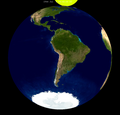 |
 |
 |
| 2002 May 26 (Saros 111) |
2031 May 07 (Saros 112) |
2060 Apr 15 (Saros 113) | |||
 |
 |
 |
 |
||
| 2089 Mar 26 (Saros 114) |
2118 Mar 07 (Saros 115) |
2147 Feb 15 (Saros 116) | |||
| 2176 Jan 26 (Saros 117) | |||||
Half-Saros cycle
A lunar eclipse will be preceded and followed by solar eclipses by 9 years and 5.5 days (a half saros).[8] This lunar eclipse is related to two partial solar eclipses of Solar Saros 119.
See also
Notes
External links
Wikiwand - on
Seamless Wikipedia browsing. On steroids.


